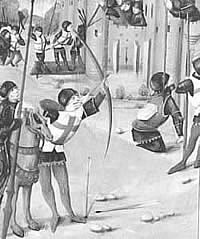THE
PENNY GAMES HISTORIES
BY
PINOCCHIO MENDES
Fibbersley 01/04/2005
Fibbersley 01/04/2005
Killer

Reynoldston Post Office and Chapel. Circa 1900
On the Gower there is a tradition that Killer (the original name for Penny Blue) had been played for centuries in the villages south of Cefn Bryn. If this is true then the peninsula must surely be from where Penny Blue originated. However, it is played there no longer and remains the least played of the five penny games.
Unfortunately, there is no written evidence of it being played at all until 1850 when, in a letter to his brother, dated November 1st, Myrddin Lewis of Holm Oak Cottage, Reynoldston, notes that his son was 'overcome with melancholy' for having 'wrecked his board so that assassins hop like crickets.'
The tradition states that it was a game beloved of smugglers who 'worked' the coast from Rhossili to Port Eynon in the eighteenth and early nineteenth centuries.
Penny
Black

The wench is saying, "Yo doh wanna scut in the dirt our kid. Get a Penny Black board. It's bostin!"
The game of marbles was brought to Britain by the Romans and soon spread to all parts of the British Isles. The 'clays' were knocked out of a circle drawn in sand or dirt by a larger 'tolley' that was propelled out of a player's hand by his thumb. Moving the hand was called fudging and was banned.
During the industrial revolution, in the public houses of the Black Country, factory workers substituted table tops for dirt circles and farthing coins for marbles. Gradually new rules were formed and the game developed into what we today would recognise as Penny Black. Originally it was called Father Black because most people played with farthings and the black one, by then, had been given a points value of six.
The rules, as we know them today, were first written down in June 1903, prior to an inter pub match between the Royal Oak of Tipton and the Rose and Crown of Gospel Oak. Sadly, both establishments have since been demolished.
Penny
Green

The garden of 21 Lindale Avenue. Behind it were the air raid shelters.
Photograph circa 1959
Penny Green was invented during the second World War by Dennis Baskerville of Stetchford, Birmingham, England.
When German bombers flew overhead Dennis' family, along with many others in his street took refuge in the shelters of a biscuit factory whose land adjoined their gardens. There, by lamp light, using farthing coins and a tea tray, he made up and played, with his boys, a football game.
He was a keen player of Penny Black and Penny Red and incorporated many of their rules. After the war he continued to refine his game until it became what it is today.
Neighbours still recall how even at the height of the bombing, he would often leave the shelter and return minutes later with a pot of tea and a plate of biscuits as if he hadn't a care in the world.
Penny
White

Hill Top High School and the school badge circa 1990
Penny white is a coin version of indoor bowls. It was first played in the form shown on this web site by the pupils of Hill Top High School, West Bromwich, England, in the nineteen eighties. It developed quite naturally from a group of students and their teachers who already played the other penny games.
"We hit on the idea that a penny could be flicked from the whole width of a board. This opened up many different angles of approach to the white and compensated for the fact that coins, not being biased, will not curve." - Guy.
Playing
the Red

English archers laying seige to Jerusalem
The
first references to 'playing the red' are in medieval manuscripts, which
tell of English archers playing it on their journey to the Holy Land.
Pennies and an oak board polished with beeswax were used. Players would sometimes prick their fingers and let their blood drip on to the red (hence the name) before the start of a match. This signified that the winner was allowed to keep the bloodstained coin.
The last medieval Penny Red board was kept in England's oldest pub: the Jerusalem Trip, which is built into the castle wall in Nottingham. The board was stolen by university students in 1976 and has never been returned.
N'ere
marry an archer who doth play the red
For upon our King thy heart shall be bled
And thou shalt be poor be he living or dead."
For upon our King thy heart shall be bled
And thou shalt be poor be he living or dead."
From a Leicestershire folk song. In the 14th century an english archer
would be paid about 3p per day.
